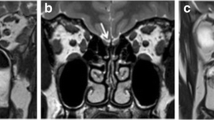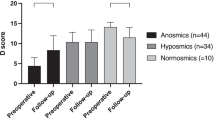Abstract
Introduction
This study was attempted to investigate the relationship between radiologic and endoscopic findings and pre- and post-operative olfactory scores in chronic rhinosinusitis with nasal polyps.
Materials and methods
In this study, 40 patients aged 19–64 years with chronic rhinosinusitis with nasal polyps (CRSwNP) undergoing endoscopic sinus surgery were involved. The patients’ olfactory status was evaluated using Smell Identification Test (Iran SIT) before and 3 months after the surgery. Patients’ nasal endoscopic signs were recorded using Modified Lund–Kennedy scoring system before and 3 months after the surgery and radiological symptoms were recorded based on Lund–Mackay CT scoring before the surgery. Then the relationship between olfactory status and endoscopic and radiological findings was investigated.
Results
With respect to mean of olfactory score, a significant difference was observed before and after the surgery (p value = 0.001). There was a significant difference between means of pre- and post-operative endoscopy scores (p value = 0.001). Pre-operative endoscopic and CT scan scores had a negative correlation with pre- and post-operative olfactory scores (p value < 0.05). Pre-op. olfactory scores had negative correlation with post-op. endoscopy scores (p value = 0.02). Post-op. olfactory scores had negative correlation with post-op. endoscopy scores but was not statistically significant (p value = 0.22).
Conclusion
Our results revealed that pre-operative endoscopy and radiology findings were consistent with the olfactory status of patients with CRSwNP before and after endoscopic sinus surgery.
Similar content being viewed by others
Avoid common mistakes on your manuscript.
Introduction
Acute and chronic rhinosinusitis are among the most common diseases worldwide. It is estimated that 30% of Americans experience symptoms of rhinosinusitis [1]. According to the duration of the symptoms, rhinosinusitis is divided into three types, namely acute (less than 4 weeks), subacute (4–8 weeks), and chronic (over 12 weeks). Chronic rhinosinusitis has been subdivided into two types, including chronic rhinosinusitis without nasal polyps and chronic rhinosinusitis with nasal polyps [2]. Sinonasal diseases cause olfactory dysfunction either by obstructing and preventing odor molecules to reach olfactory mucosa or by damaging the olfactory mucosa due to inflammation [3]. Surgery is effective in about 70–80% of cases with olfactory disorders in patients with CRSwNP. On the other hand, olfactory function does not improve in a significant number of patients following surgery and the olfaction is worsened in 8–34% and even 1% of these patients experience anosmia [2, 4]. These losses could be caused by neural damage at the time of the surgery or by a narrowing of the nasal airways by anatomic changes or scar tissue [5]. Given the importance of evaluating the olfactory dysfunction before the surgery, this study sought to investigate the relationship between radiology and endoscopy findings and olfactory function before and after surgery in patients suffering from CRSwNP. We also intend to inform the patients, and rationalize their expectations regarding the result of surgery on olfactory dysfunction.
Materials and methods
After approval by local ethic committee (IR.SSU.MEDICINE.REC.1396.550) and obtaining written informed consent, in pre–post-intervention study, 40 patients aged 19–64 years with CRSwNP undergoing endoscopic sinus surgery were involved. This study was conducted through recording laboratory data and analyzing the obtained data. Inclusion criteria included having definitive diagnosis of CRSwNP according to medical history, symptoms for at least 12 consecutive weeks, findings of nasal endoscopy and CT scan, and indication for endoscopic sinus surgery. Patients with paranasal sinus malignancies, acute rhinosinusitis, immune deficiency, cystic fibrosis, aged less than 16 or more than 65 years, previously undergoing FESS, and history of severe trauma to head, face, and sinuses [2,3,4, 6, 7] and also pregnant patients were excluded. The patients received a 5-day course of prednisolone 0.5 mg/kg in a single dose every morning before surgery and topical fluticasone 100 mcg in each nostril daily after surgery for 6 weeks. To determine the odor detection, Smell Identification Test (Iran SIT) was used in this study. Iran SIT is the Persian version of University of Pennsylvania Smell Identification Test. During this test, 24 scents are released using a pencil. The patient smells the level and detects the odor from the four choices after release of each scent. Odors are released at a supra-threshold level. The patient is scored based on the number of smells that he/she can correctly detect [8]. Our patients were evaluated by Iran SIT before and 3 months after the surgery. Before and 3 months after surgery, patients’ nasal endoscopy signs were recorded based on the modified Lund–Kennedy scoring system [9]. In this system, scores 0, 1, and 2 are considered, respectively, for the absence, limited presence, presence of polyp, edema and discharge for each side of the nose. Before surgery, radiology findings of patients were recorded based on Lund–Mackay CT scoring [10]. In this system, scores 0, 1 and 2 are considered for each of the maxillary, anterior ethmoidal, posterior ethmoidal, sphenoid and frontal sinuses based on the absence of mucosal thickness, partial sinus opacity, and complete sinus opacity, and scores 0 and 2 were considered for osteomeatal complex for each side of the nose. Data were analyzed using software of SPSS (version 22) and running mean and variance analysis as well as Chi-square test, and data were presented as the mean ± standard deviation (SD). p value less than 0.05 was considered as statistically significant.
Results
Out of 40 patients, 28 (70%) were male and 12 (30%) were female. Patients aged from 19 to 64 years, and the mean age of patients was 37.15 ± 11.55. Patients’ olfactory status was assessed by Iran SIT before and 3 months after the surgery. The mean of pre-operative olfactory score was 14.75, and the mean post-operative olfactory score was 17.05. A significant difference was observed between mean of pre-op. and post-op. olfactory scores (p = 0.001) (Table 1). Pre-op. and post-op. endoscopy findings were evaluated based on the Modified Lund–Kennedy scoring system [9]. Mean pre-op. endoscopy scores were 9.59, whereas mean post-op. endoscopy score was 3.3. Means of pre-op. and post-op. endoscopy scores differed significantly (p = 0.001) (Table 2). Radiology findings were recorded before the surgery using Lund–Mackay CT scoring [10]. Pre-op. radiology scores were between 11 and 21 with the mean of 17.05. Pre-op. endoscopy and radiology scores had a negative correlation with pre-op. and post-op. olfactory scores (p value < 0.05). Pre-op. olfactory scores had negative correlation with post-op. endoscopy scores (p value = 0.02). Post-op. olfactory scores had negative correlation with post-op. endoscopy scores but was not statistically significant (p value = 0.22) (Table 3).
Discussion
This study mainly sought to investigate the relationship between radiology and endoscopy findings and olfactory function before and after surgery in patients suffering from CRSwNP. This study, which was done on 40 patients, showed that greater symptoms severity in pre-op. radiology and pre- and post-op. endoscopy was associated with less olfactory function and endoscopic sinus surgery (ESS) would be resulted in olfactory function improvement. In our study, pre-op. endoscopy and radiology scores had a negative correlation with the pre-op. and post-op. olfactory scores (p value < 0.05), and these findings are consistent with the results of other studies in this regard. Gupta et al. [3] evaluated 40 patients with chronic rhinosinusitis to investigate the relationship between olfactory dysfunction and radiology and endoscopy symptoms before and after ESS. They revealed that the severity of olfactory dysfunction determined by olfactory test was well correlated with findings of nasal endoscopy and radiology (p value < 0.001). In their study, patients suffering from chronic rhinosinusitis with and without NP were studied [3] and their findings are in line with result of our study. Rudmik and Smith studied olfactory improvement after ESS in 111 patients and demonstrated a positive correlation between post-op. olfactory function recoveries and the severity of polyposis as well as severity of pre-op. olfactory function loss. In the aforementioned study, patients with and without NP was compared. It was concluded that patients with CRSwNP had a greater chance of experiencing olfactory function improvement after ESS, which is similar to findings of our study [7]. Oka et al. [11] evaluated olfactory changes in patients with chronic rhinosinusitis after ESS. They also showed that chronic rhinosinusitis-induced olfactory dysfunction improved after ESS [11]. Rahman et al. evaluated ESS outcome considering the treatment of chronic rhinosinusitis. They have emphasized that ESS plays a key role in the treatment of patients withCRSwNP and CRSsNP, and it is efficient in improving the disease symptoms, including decreased olfactory function [12]. Murthy and Banerjee [13] examined predictive factors following ESS and reported the improvement of all symptoms such as olfactory function (p value < 0.001). Nevertheless, they suggested no relationship between olfactory score and Lund–Mackay CT score before surgery [13], which is in contrast with the findings of our study.
Conclusion
According to the results of this study, olfactory status was improved after the surgery in patients with CRSwNP. Also our results revealed that pre-op. endoscopy and radiology findings were consistent with the olfactory status of patients with CRSwNP.
Limitations
Due to ethical considerations, CT scan was not performed after surgery and pre-op. endoscopy/radiology score and post-op. endoscopy score were used.
References
Lanza DC, Kennedy DW (1997) Adult rhinosinusitis defined. Otolaryngol Head Neck Surg 117(3_suppl):S1–S7
Friedman WH, Katsantonis GP, Bumpous JM (1995) Staging of chronic hyperplastic rhinosinusitis: treatment strategies. Otolaryngol Head Neck Surg 112(2):210–214
Gupta D, Gulati A, Singh I, Tekur U (2014) Endoscopic, radiological, and symptom correlation of olfactory dysfunction in pre- and postsurgical patients of chronic rhinosinusitis. Chem Senses 39(8):705–710
Krouse JH, Chadwick SJ, Gordon BR, Derebery MJ (2002) Allergy and immunology: an otolaryngic approach. Lippincott Williams & Wilkins, Philadelphia
Donald AL, Eric HH (2015) Physiology of olfaction. Cummings otolaryngology: head and neck surgery, vol 1. Elsevier, Saunders, p 640
Kennedy DW (1985) Functional endoscopic sinus surgery: technique. Arch Otolaryngol 111(10):643–649
Rudmik L, Smith TL (2012) Olfactory improvement after endoscopic sinus surgery. Curr Opin Otolaryngol Head Neck Surg 20(1):29
Taherkhani S, Moztarzadeh F, Seraj JM, Nazari SSH, Taherkhani F, Gharehdaghi J et al (2015) Iran Smell Identification Test (Iran-SIT): a modified version of the University of Pennsylvania Smell Identification Test (UPSIT) for Iranian Population. Chemosens Percept 8(4):183–191
Psaltis AJ, Li G, Vaezeafshar R, Cho KS, Hwang PH (2014) Modification of the Lund-Kennedy endoscopic scoring system improves its reliability and correlation with patient-reported outcome measures. Laryngoscope 124(10):2216–2223
Hopkins C, Browne JP, Slack R, Lund V, Brown P (2007) The Lund-Mackay staging system for chronic rhinosinusitis: how is it used and what does it predict? Otolaryngol Head Neck Surg 137(4):555–561
Oka H, Tsuzuki K, Takebayashi H, Kojima Y, Daimon T, Sakagami M (2013) Olfactory changes after endoscopic sinus surgery in patients with chronic rhinosinusitis. Auris Nasus Larynx 40(5):452–457
Rahman T, Alam M, Ahmed S, Karim M, Rahman M, Wahiduzzaman M (2016) Outcome of endoscopic sinus surgery in the treatment of chronic rhinosinusitis. Mymensingh Med J 25(2):261–270
Murthy P, Banerjee S (2013) Predictive factors for a good outcome following endoscopic sinus surgery. Indian J Otolaryngol Head Neck Surg 65(2):276–282
Author information
Authors and Affiliations
Corresponding author
Ethics declarations
Conflict of interest
Authors have no conflicts of interest.
Ethical statement
Study protocol was in accordance with the latest Declaration of Helsinki for medical research involving human subjects and was approved by ethics committee of Shahid Sadoughi University of Medical Sciences.
Human/animal right statement
This article does not contain any studies with animals performed by any of the authors.
Informed consent
Informed consent was obtained from all participants of the study.
Rights and permissions
About this article
Cite this article
Dadgarnia, M., Rahmani, A., Baradaranfar, M. et al. The relationship between endoscopic and radiologic findings and olfactory status of patients with chronic rhinosinusitis with nasal polyps before and after the endoscopic sinus surgery. Eur Arch Otorhinolaryngol 276, 397–400 (2019). https://doi.org/10.1007/s00405-018-5221-z
Received:
Accepted:
Published:
Issue Date:
DOI: https://doi.org/10.1007/s00405-018-5221-z




